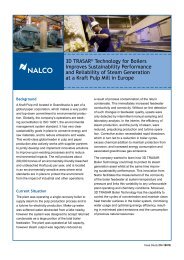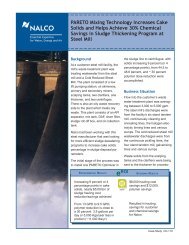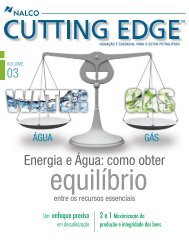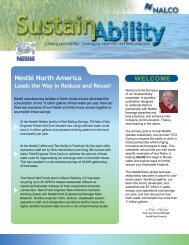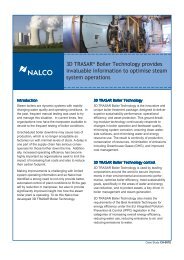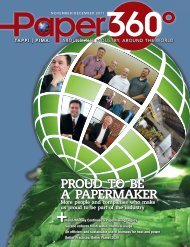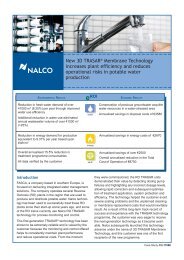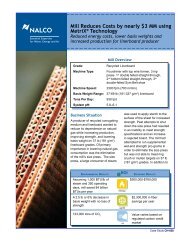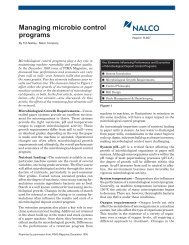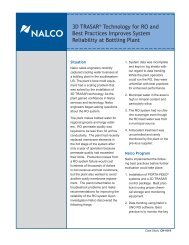PARETO® Mixing Technology - Nalco
PARETO® Mixing Technology - Nalco
PARETO® Mixing Technology - Nalco
You also want an ePaper? Increase the reach of your titles
YUMPU automatically turns print PDFs into web optimized ePapers that Google loves.
PARETO ® <strong>Mixing</strong> <strong>Technology</strong><br />
An InnOvATIvE, InTEgRATEd SOluTIOn APPROAch
PARETO <strong>Mixing</strong> <strong>Technology</strong><br />
has been specifically<br />
designed to reduce the<br />
inefficiencies and challenges<br />
that are inherent in<br />
traditional papermaking<br />
methods.<br />
PARETO <strong>Mixing</strong> <strong>Technology</strong><br />
A patented, engineered system that enhances chemical performance<br />
by optimizing the injection of the chemical additives into industrial<br />
process streams, PARETO <strong>Mixing</strong> <strong>Technology</strong> allows for a more uniform<br />
additive distribution to be achieved in a shorter time compared to<br />
traditional injection systems. For applications such as flocculant<br />
addition into the wet-end of the paper machine system, water savings,<br />
energy savings, increased production and quality improvement can all<br />
be achieved when this innovative solution is used to replace traditional<br />
injection technologies.<br />
PARETO technology represents a major advancement in chemical<br />
injection applications that has been confirmed in success at multiple<br />
commercial installations. It is applicable to most chemical injections<br />
and is specifically applicable to high molecular weight polymers as is<br />
typically encountered in water treatment applications and/or products<br />
being fed in the top of a chest (dripped in open tanks) such as de-<br />
foamers, hybrids or coagulants (organic and inorganic).<br />
In reviewing the fundamentals of injection technology, there are a<br />
number of methods utilized for chemical delivery into process pipes<br />
including direct hose/pipe connection (i.e. T-jet type of connection),<br />
injection stub, drilled quill and several newer more novel engineered<br />
methods. Each of these methods has inherent advantages and<br />
disadvantages to the papermaker and requires certain compromises<br />
and technical tradeoffs in order to be successfully implemented.<br />
PARETO technology has been specifically designed to reduce the<br />
inefficiencies and challenges that are inherent for these methods.<br />
While PARETO technology is applicable to all chemical additions,<br />
it is particularly effective in optimizing flocculant dosing due to the<br />
rapid and irreversible nature of the polymer adsorption process onto<br />
system additives.
Innovative Solutions to Meet<br />
Your Challenges<br />
The primary purpose of the PARETO Optimizer (Figure 1) is to discharge<br />
the mixture of additive and feeding water into the pipe in a desired way<br />
by ensuring: (a) rapid mixing of chemical into stream and (b) mixing of<br />
chemical with the feeding water under controlled hydrodynamic<br />
conditions to prevent any deactivation of the chemical.<br />
The PARETO Optimizer is connected through an adapter on the pipe, as<br />
can be seen in Figure 2. It is essential to use the specially designed adapter<br />
to connect the optimizer on the pipe in order to pre-mix the feed liquid<br />
and chemical to ensure the consistent penetration of this mixture into the<br />
process pipe. The material of construction is stainless steel AISI 316.<br />
As seen in Figure 3, the conventional representation 10 m (33 ft) downstream<br />
– a distance that post screen is many times in the headbox or<br />
Clarification Unit as DAF - a complete mixing has not yet occurred,<br />
resulting in high localized concentrations of chemicals – or floc formations.<br />
This results in not only reduced chemical efficacy but variability in floc<br />
formation, which can have a detrimental impact on certain finished<br />
product attributes such as formation, porosity and moisture profiles,<br />
as well as an impact on operational efficiency.<br />
As illustrated at the bottom of Figure 3, nearly complete mixing occurs<br />
within 7 meters (23 ft.) of injection. This eliminates many of the issues<br />
resulting from poor mixing and allows for opportunities to move the<br />
injection point closer and enhance polymer performance.<br />
Figure 1 - PARETO Optimizer<br />
Figure 2 - PARETO Optimizer<br />
installation<br />
T-Jet<br />
Distance to<br />
Unit Operation<br />
(Headbox/DAF/<br />
Clarifier/etc)<br />
PARETO<br />
Figure 3<br />
T-Jet vs. PARETO <strong>Mixing</strong> <strong>Technology</strong><br />
Feedpoint<br />
3 m (10 ft)<br />
20%<br />
Well Mixed Area %<br />
10%<br />
Well Mixed Area %<br />
7 m (23 ft)<br />
65%<br />
25%<br />
87%<br />
10 m (33 ft)<br />
55%
PARETO <strong>Mixing</strong> <strong>Technology</strong><br />
Benefits<br />
When PARETO technology is coupled with extensive<br />
chemical technologies and system assurance practices<br />
offered by <strong>Nalco</strong>, customers then have a complete,<br />
comprehensive solution unlike any in the industry<br />
that can deliver unparalleled results and value. Use<br />
of PARETO technology is also an important way that<br />
<strong>Nalco</strong> customers can achieve significant water and<br />
energy savings and enhance their commitment to<br />
sustainability. <strong>Nalco</strong> also reports Environmental<br />
Return on Investment (e ROI ) values to customers<br />
to account for contributions in delivering both<br />
environmental performance and financial payback.<br />
PARETO technology has also demonstrated increased<br />
polymer efficiency/effectiveness in a number of<br />
program implementations, and additionally, customers<br />
have gained system stability and increased unit<br />
(Paper Machine/DAF/Sludge Press/Washer/Clarifier)<br />
performance through use of this technology.<br />
PARETO technology can be utilized in both<br />
on-machine, RDF applications, as well as non-RDF<br />
environments, as seen through the benefits on<br />
the next page.<br />
Paper Process Applications – On-Machine RDF<br />
(Retention/Drainage/Formation) Programs<br />
Different types of papermaking chemicals can be introduced with<br />
PARETO technology, such as flocculants, microparticles, sizing agents,<br />
starch, and wet and dry strength aids. Typically the biggest impact on<br />
chemical consumption is to move the addition point closer to headbox,<br />
(from pre-screen to post-screen) and by doing this some or all the<br />
following can be achieved:<br />
Reduced fresh water consumption (process water replacing<br />
fresh water, usually in secondary polymer dilution)<br />
Reduced energy costs<br />
Reduced chemical product use<br />
Increased runnability (reducing wet web breaks caused by<br />
holes and improving sheet profile)<br />
Sheet specification achievements such as sheet ash and<br />
formation (quality)<br />
Non-RDF Paper Applications<br />
Water treatment programs are very dynamic processes and variability<br />
can be caused by mechanical conditions, operational practices or simply<br />
because of the nature of the raw/waste treatment plant (variability of<br />
the contaminants in the stream). By installing PARETO Optimizers in this<br />
area, <strong>Nalco</strong> has been able to minimize this variability for customers even<br />
though the conditions may not be optimal. Results typically seen in these<br />
applications are:<br />
Improved system performance and operational stability<br />
Reliable treatment performance for raw/water treatment plants<br />
Reduced chemical consumption through more effective mixing<br />
in the process stream (10 – 40 percent) and potential to move<br />
chemical addition points to a lower shear area (where applicable)<br />
Replacing fresh water with a stable process/clarified water source
Marketplace Applications<br />
PAPERMAKING PROCESS<br />
PARETO technology is applicable to many different chemical injection processes. When<br />
integrated with <strong>Nalco</strong> flocculant and microparticle programs, the resulting wet-end program<br />
can deliver enhanced value to customers’ operations and therefore offer a truly unique<br />
program that differentiates it from any other alternative solutions. This is particularly true<br />
for existing pre-screen flocculant additions and for polymer additions that have insufficient<br />
dilution water. In these cases, PARETO <strong>Mixing</strong> <strong>Technology</strong> can significantly improve the<br />
current chemical injection situation and achieve further improvement by enabling retention<br />
aids to be dosed post-screen, achieving the following:<br />
Retention/Drainage aid application points can be moved post-screen closer to the<br />
headbox to reduce chemical consumption and minimize negative impacts on formation<br />
This safe and innovative technology enables chemical additives to be diluted by<br />
process water instead of fresh water, resulting in significant water and energy savings<br />
Other wet-end chemicals such as sizing agents, starch, wet and dry strength aids<br />
and other process additives can all be fed through use of PARETO Optimizers<br />
C<br />
E<br />
C<br />
A<br />
D<br />
NON-RDF (PAPER PROCESS) or WATER TREATMENT<br />
B<br />
The use of PARETO technology is also applicable to other chemical applications on paper<br />
machines, DAFs, sludge presses, pulp mill washing, and other unit operations (typically<br />
without the Feed Skid component involved in paper process). Current installations include:<br />
A. Sludge Thickening (Dewatering)<br />
• Increasing sludge cake solids and optimizing polymer dosage<br />
B. Solid Liquid Separation (DAF’s/Clarifiers)<br />
• Improving system stability and getting better clarified water to be re-used<br />
C. Defoamer (Pulp and Paper Machines/Steel Mill)<br />
• Enhancing treatment by moving feedpoints in open ducts to a closed pipe<br />
D. Broke Treatment<br />
• Narrowing normal variation of anionic charge allowing better process control<br />
E. Raw Water Treatment<br />
• Reducing raw water variations and optimizing coagulant usage
Program Design/Installation<br />
PARETO OPTIMIzER<br />
The PARETO Optimizer is able to mix chemical agents and process water prior to its<br />
introduction into the process pipe, with the engineered system minimizing the contact<br />
time between the solutions. This means the injected chemical agents are optimally mixed<br />
with the pressurized feed water just prior to introduction into the process (Fig. 4).<br />
The chemical is fed axially into the core of the reactor. The feeding liquid is fed tangentially<br />
into the low shear zone so that in the reaction chamber the chemical is fully mixed with the<br />
feeding liquid under controlled shear intensity and reaction time. At the outlet, the conical<br />
jet is discharged into the approach pipe’s furnish with the goal being to spread the mixture<br />
as widely and quickly as possible, as seen in Figure 5.<br />
The required maintenance of the PARETO system is also simple and safe. The optimizer<br />
has been designed to be robust, durable, and easy to install and disassemble for inspection<br />
and cleaning. The main components of the system, such as the pump, flow meter(s), hoses,<br />
valves, are constructed of the highest quality industry materials available in the market.<br />
Periodical checking of the PARETO system is required in order to observe any changes in<br />
pressures and flows from the designed values. At paper machine shutdowns, the optimizers<br />
can also be opened for inspection.<br />
BOOSTER PUMP<br />
The booster pump provides the necessary dilution water flow and pressure increase to<br />
properly mix the wet-end chemicals and furnish. The output of the pump can be varied to<br />
deliver the precise amount of dilution water required for the application. Multi-Stage<br />
Vertical and Single Stage Horizontal Pumps are illustrated in Figures 6 and 7.<br />
A constant volume and pressurized source is required, and it is possible to source and<br />
supply this to the Self Balancing Manifold (SBM) (Fig. 8). Depending on the Optimizer type<br />
and the number required, the total volume of feed water required will be determined as<br />
part of the site surveys.<br />
Figure 4 – Typical PARETO Optimizer installation assembly<br />
Figure 5<br />
Drive Fluid (water) Inlet<br />
Figure 7 – Single Stage Horizontal Pump<br />
Chemical Inlet<br />
Figure 6 – Multi-Stage Vertical Pump<br />
Figure 8 – Self Balancing Manifold 4 gang
Program Design/Installation<br />
SELF BALANCING MANIFOLD (SBM)<br />
SBMs, as seen in Figure 9, are used to equally distribute chemical and the dilution feed water<br />
to the PARETO Optimizers when using three or more optimizers (commonly in Papermaking<br />
Process). The SBMs are recommended for installation close to the chemical addition point.<br />
Solid pipe connection can be used between the pump and the SBM, while from the SBM to<br />
the PARETO Optimizers it is recommended to use flexible piping for easy maintenance.<br />
Typically in water treatment applications or non-RDF paper applications there is not a<br />
need for two or more PARETO Optimizers. Therefore, if a customer is commonly using<br />
one Optimizer there is no need for a self-balancing manifold, as illustrated in Figures 10, 11,<br />
12, and 13. As illustrated in Figure 14, PARETO is a custom engineered solution that<br />
ensures homogeneity exists between chemical application and the steady-state process.<br />
PARETO Optimizer - To ensure proper chemical injection<br />
Feed Skid - Shear (power, energy and type)<br />
Chemistry - Molecular weight, charge, architecture<br />
Best Practices - Replacement of fresh water with process water for energy and<br />
water conservation<br />
Figure 14 – Components of PARETO<br />
<strong>Technology</strong> Offering<br />
Figure 10 – One Optimizer at DAF Inlet<br />
Figure 9 –Actual installation of the SBM for feed<br />
water and in the background the solution filters<br />
with SBM<br />
Figure 11 – One Optimizer at Raw Water<br />
Clarifier inlet<br />
Figure 12 – One Optimizer at Pulp Washer Figure 13 – One Optimizer at Screw Press
PARETO <strong>Mixing</strong> <strong>Technology</strong> – Customer Value Delivered<br />
Recycled Linerboard Mill (RDF)<br />
e ROI Results: Reduced 10.4 MM gallons per year of softened fresh water.<br />
30% improvement in formation measured by the PPF formation tester.<br />
Region: North America, Recycled Linerboard Mill (RDF).<br />
Background: Key drivers for this customer were to reduce overall costs and fresh water<br />
consumption.<br />
Challenges: Poor injection of cationic flocculant program had led to variable paper quality,<br />
higher energy costs, and lower retention efficiency.<br />
Solution: Converted flocculant program from conventional drilled quill assembly to PARETO<br />
technology system; eliminated use of fresh water and switched to white water use<br />
for dilution of retention aid with improved performance.<br />
Uncoated Freesheet Paper Manufacturer (RDF)<br />
e ROI Results: Water savings of 26,460,000 gallons/year; 11% reduction in<br />
overall chemical use.<br />
Region: Asia Pacific, UCFS Paper Manufacturer (RDF).<br />
Background: Customer‘s key business driver was improvement of machine productivity;<br />
mill’s operational goal was an On-Machine Efficiency (OME) rate of 85%.<br />
Challenges: Mill needed to effectively reduce wet-end process variability as well as<br />
improve tray consistency variability.<br />
Solution: Mill implemented PARETO technology on the RDF program to manage control<br />
of tray consistency.<br />
Waste Water Treatment Plant (Steel Mill)<br />
e ROI Results: Increased cake solids from 44% to 49%; reduction in hauling cost ~<br />
$5 /Ton; total savings of > $20,000/year.<br />
Region: North America, Sludge Thickening (Centrifuge) in Waste Water Treatment Plant (Steel Mill).<br />
Background: Customer wanted to improve cake solids percentage; also wanted to increase<br />
sludge solids content closer to 50%.<br />
Challenges: The solids discharged were being hauled away to a landfill and the centrate was<br />
being returned to the wetwell.<br />
Solution: Converted polymer program from conventional T-jet injection assembly to<br />
PARETO technology system. PARETO system on centrifuge was also installed<br />
with the same feedpoint being used.<br />
Waste Water Treatment Plant<br />
e ROI Results: 75% less fresh water usage in DAF/Meri system; also reduced<br />
polymer dose 17-40%.<br />
Region: Latin America<br />
Background: Customer wanted to improve system efficiency to increase overall stability of DAF.<br />
Challenges: Conventional T-jet injection system of polymer was requiring higher dosages<br />
of cationic flocculant.<br />
Solution: Converted polymer program from conventional T-jet injection assembly to<br />
PARETO technology system and also installed PARETO system on 2 Meri units<br />
and 1 Krofta DAF unit.<br />
Pulp Mill Manufacturer Washer (Defoamer)<br />
e ROI Results: Reduced defoamer dosage by 30%; customer was also able to achieve<br />
$50,000/year in financial savings.<br />
Region: North America, Pulp Mill Manufacturer Washer (Defoamer).<br />
Background: Mill wanted to improve defoamer distribution to washer to increase its efficiency<br />
and reduce overall defoamer dosage.<br />
Challenges: <strong>Nalco</strong> had been working with this pulp manufacturer, who was looking to<br />
implement more efficient foam control programs.<br />
Solution: New foam control program was implemented from conventional feeding<br />
to PARETO technology system. PARETO technology system was also integrated<br />
onto the vat dilution line.<br />
Raw Water Treatment Plant<br />
e ROI Results: Process Stability (less blowdowns) and >34% reduction<br />
in chemical treatment.<br />
Region: North America, Raw Water Treatment in Tissue Paper mill.<br />
Background: This large tissue paper manufacturer had to replace alum for a more friendly<br />
chemistry in clarifier treating raw water.<br />
Challenges: Treating 44,000,000 GPD and get clear well turbidity goal
asset raw<br />
protection materials<br />
See PARETO Savings...<br />
in real time<br />
current PARETO technology energy and water<br />
savings figures are always available in real time at<br />
www.nalco.com/pareto, as seen in the screen<br />
shots to the right.<br />
For further information on PARETO <strong>Mixing</strong> <strong>Technology</strong>,<br />
please visit http://www.nalco.com/applications/pareto.htm.<br />
safety raw<br />
materials<br />
asset<br />
protection<br />
raw<br />
materials<br />
NALCO COMPANY<br />
North America – 1601 West Diehl Road • Naperville, Illinois 60563-1198 • USA<br />
Energy Services Division – 7705 Highway 90-A • Sugar Land, Texas 77478 • USA<br />
Europe: A-One Business Center • Z.A. La Pièce 1 • Route de l’Etraz • 1180-Rolle • Switzerland<br />
Gulf Office: P.O. Box 17063 • Jebel Ali Free Zone • Dubai, United Arab Emirates<br />
www.nalco.com<br />
PARETO, e ROI , <strong>Nalco</strong> and the logo are Trademarks of <strong>Nalco</strong> Company<br />
Ecolab is a trademark of Ecolab USA, Inc.<br />
©2012 Ecolab USA Inc. All rights reserved Printed in USA 2/12 B-1259




